Research Article Open Access
Aerobic Treatment of Handmade Paper Industrial Effluents by White Rot Fungi
| Shweta Kulshreshtha1*, Nupur Mathur2 and Pradeep Bhatnagar3 | |
| 1Amity Institute of Biotechnology, Amity University of Rajasthan, Jaipur, India | |
| 2Department of Zoology, University of Rajasthan, Jaipur, India | |
| 3International College for Girls, Mansarovar, Jaipur, India | |
| Corresponding Author : | Shweta Kulshreshtha Amity Institute of Biotechnology Amity University of Rajasthan, Jaipur, A-200 Vaishali Nagar, Jaipur-302021, India Tel: +91-9460553136 Email: shweta_kulshreshtha@rediffmail.com |
| Received April 05, 2012; Accepted May 07, 2012; Published May 09, 2012 | |
| Citation: Kulshreshtha S, Mathur N, Bhatnagar P (2012) Aerobic Treatment of Handmade Paper Industrial Effluents by White Rot Fungi. J Bioremed Biodeg 3:151. doi: 10.4172/2155-6199.1000151 | |
| Copyright: © 2012 Kulshreshtha S, et al. This is an open-a ccess article distributed under the terms of the Creative Commons Attribution License, which permits unrestricted use, distribution, and reproduction in any medium, provided the original author and source are credited. | |
Related article at Pubmed Pubmed  Scholar Google Scholar Google |
|
Visit for more related articles at Journal of Bioremediation & Biodegradation
Abstract
Modernization of handmade paper industries has led to increase in production capacity for fulfilling demand. This also leads to the use of chemicals and dyes to make attractive and colourful papers. These industries recycle white and coloured cotton rags procured from textile industries. After processing and making paper, these industries discharge large amount of effluent in nearby water sources and deteriorate quality of water. Therefore, it is an urgent need to treat waste water in order to reduce the effect on the human beings as well as on the environment. The present study deals with physicochemical and genotoxicological analysis of Large Scale Handmade Paper industrial (LS-HMP) and Small Scale Handmade Paper industrial (SS-HMP) effluents before and after treating them with White Rot Fungi (WRF) in nutrient amended and non-amended condition. SS-HMP and LS-HMP were found to possess basic pH i.e. 7.54 and 8 respectively. These industrial effluents were found to possess colour revealed by 11293.3 (SS-HMP) and 11880 (LS-HMP) colour units and high COD revealed by 1132.6mg/l (SS-HMP) and 12371.7mg/l (LS-HMP), on initial day which reduced significantly to the safe discharge limits by white rot fungi. Similarly, basepair and frameshift mutagenicity were reduced significantly on treatment. Among all WRF, P. chrysosporium was found to be equally effective in both nutrient amended and non-amended condition in reducing all parameters of SS-HMP and LS-HMP effluent. Thus, P. chrysosporium can be used for the treatment of handmade paper industrial effluent without nutrient supplementation
| Keywords |
| Aerobic treatment; Fungal treatment; Handmade paper industries; Mutagenicity; Mutagenicity reduction |
| Introduction |
| The demand and consumption of paper is increasing day by day and presently it has become such an important part of our life that one can’t imagine living without it. As far as the production of paper in India is concerned, there are not only the conventional paper mills using mechanized paper making process but there is also a real existence of ancient traditional craft of handmade paper making. Handmade paper industries are also spread all over in Asian, European and American countries. The demand for handmade paper and its allied products is increasing not only in domestic market but also in international market. The handmade paper production uses exclusively non-forest raw materials; it is particularly well suited to internal recycling and is not centralized in large-scale units. Developing countries are facing shortages of raw materials, energy sources and capital therefore, the development of the handmade paper industry offers considerable potential to meet the increasing demand for paper products. These industries are thought to be producing handmade paper in a friendly environmental way. |
| Nowadays, due to increasing demand and popularity of handmade paper, these industries have started the use of dyes and chemical additives to impart certain qualities to paper and to make it attractive. Handmade paper industries are also utilizing a huge amount of water in different steps of making paper. After utilization, this is discharged to the nearby water bodies in its untreated form along with the dissolved chemicals or dyes. The physico-chemical parameters assessed earlier by Kulshreshtha et al. [1] and found to be much above the discharging limit of CPCB (2000) [2]. Besides this, effluent was found to be mutagenic and found to possess basepair and frameshift mutagens [3]. Hence, there is an urgent need of treatment of this effluent. |
| A lot of work has been done on biological approach of decolourization and detoxification of industrial effluents [4-6] and dye solutions [7-9]. However, in biological treatment processes effect of biological treatment on mutagenicity of dye or effluent is meagrely reported [10]. Handmade paper industries are thought to be eco-friendly industries, therefore, no physico-chemical or biological treatment strategies have been employed so far. Various investigations have been shown that kraft paper and pulp mill effluents can be degraded and decolorized by white rot fungi Phanerochaete chrysosporium, Fomes lividus, Pleurotus spp. and Trametes versicolor [11-14]. Thus, this study was aimed at finding the effect of white rot fungi (WRF) on the physico-chemical parameters and mutagenicity of pre-treated and post-treatment handmade paper industry’s effluent. |
| Methodology |
| Study area |
| Sanganer near Jaipur is the biggest center in western India humming on the rhythm of the sound of paper making activities. This place is popular for developing its own special varieties of handmade paper. Artisans in this area are involved in producing paper by using white or coloured cotton rags, hence, recycling the waste of textile industries. This area shows mushrooming pattern of small scale and large scale handmade paper industries. Small scale handmade paper industries produce 2 reams per day while large scales handmade paper industries produce more than 2 reams per day. Large-scale integrated units consume large quantities of water, electricity and chemicals and are source of pollution due to discharge of large amounts of untreated effluent. Small-scale agro-based units are severely polluting, as they are usually unable to afford pollution control equipment and may compromise with the quality of dyes or chemicals. Thus, this area is suitable for the present study due to having both categories of handmade paper industries. |
| Collection and characterization of effluent |
| Fungal culture and maintenance: Phanerochaete chrysosporium was purchased from Microbial type collection center, Chandigarh, India. Pleurotusflorida and Pleurotuscitrinopileatus were collected from National center for mushroom research, Chambaghat, solan, India and Agricultural research station, Durgapura, Jaipur, India respectively. These strains were subcultured on PDA and preserved at 4°C. |
| Physico-chemical characterization of effluent: Effluent samples of handmade paper and cardboard industries were collected in presterilized plastic containers and analyzed immediately in the laboratory for pH, COD and colour of the effluent as per guidelines given in APHA (1995) [15] which are the main parameters to be considered for most of the biological treatment processes. |
| Mutagenicity assay/ Ames assay |
| On initial day, effluents were also analyzed for mutagenicity by Ames assay or Salmonella microsomal mutagenicity assay. All effluent samples were tested in their crude natural state without concentration. The Salmonella microsome reversion assay was conducted using the plate incorporation procedure described by Maron and Ames [16] using TA 98 and TA 100 strains of Salmonella typhimurium. |
| The samples were analyzed with and without the hepatic S9 fraction, which incorporates an important aspect of mammalian metabolism into the in-vitro test. Samples were tested on duplicate plates. Five dose levels (2 μl, 5 μl, 10 μl, 50 μl and 100 μl) of individual samples were tested. Positive control used for TA 98 and TA 100 was 2-Nitrofluorine (1 μg/plate: 104 revertants) and Sodium azide (1 μg/ plate: 594 revertants) respectively. On adding metabolic activation system i.e., S9 mix (prepared from uninduced liver of mouse as used by Prival et al. [17] revertants per plate in positive control increased as TA 98 (1 μg/plate: 481) and TA 100 (1 μg/plate: 897). Sterile distilled water was used as negative control. All readings were taken in duplicates. |
| Effluent treatment with white rot fungi (WRF) |
| Handmade paper and cardboard industrial effluent was treated with 3 different white rot fungi in aerobic condition. In this study, effluent was neither diluted nor sterilized. These were treated directly in raw form as obtained from industries. 400ml amount of each effluent was taken separately in eight sterilized 1l Erlenmeyer flasks. All 8 flasks were divided in the two set of 4 flasks. Out of two groups of effluent containing flasks, glucose (1g/l) as carbon and ammonium chloride (0.25g/l) as nitrogen source was added to one group of 4 flasks [18-20]. Another group of flasks were used without adding any nutrient. |
| All fungi were grown on Potato Dextrose Agar (PDA) for 7 days for inoculation of flasks. Fungi were inoculated in the form of four mycelial discs of 0.5cm diameter in each flask, which were cut out with the help of a borer (0.5cm diameter) from the zone of active growth on a Petridish [21]. In all the assays, flasks were incubated in shaken (120 rev/min) condition for 12 days at 37 ± 1°C [22]. Withdrawals of samples were made on every 3rd day of experiment till 12th day. Readings were reported as % decrease or increase in parameters. |
| Control |
| Two controls of effluent samples were used in the present study. One was amended with nutrient while the other was not. In both of these effluent containing flasks, fungus was not added. These controls were used to compare the effect of fungi in nutrient amended and nonamended effluent with their respective controls. |
| Post-treatment analysis |
| After fungal treatment, physico-chemical and mutagenicity was analyzed using the same protocol. |
| Result and Discussion |
| In the present investigation, handmade paper industry’s effluent characteristics were recorded in the terms of pH, COD, colour and mutagenicity on the initial day and depicted in (table 1). On initial day, small scale handmade paper (SS-HMP) industry’s effluent possess slightly basic pH (7.54), very high COD (11293.3 mg/l) and red colour having 1132.6 Pt-Co units. Besides this, effluent was found to be mutagenic only with TA98 strain revealing the presence of frameshift mutagens (table 1). On adding S9mix, mutagenicity of the effluent was not found to decrease indicating that liver enzymes of eukaryotic system were not capable of reducing the mutagenicity of effluent. However, no basepair mutagens were detected in the effluent. |
| Similarly, large scale industrial (LS-HMP) effluent was also found to possess basic pH (8), comparatively less COD (11880mg/l) and very high colour (12371.7 Pt-Co units). This black coloured effluent was found to possess basepair mutagens detected by strain TA 100 which increased on adding hepatic fraction of mouse liver (table 1). Moreover, this effluent also possessed indirect frameshift mutagens revealing the absence of frameshift mutagens in the absence of S9 mix. On addition of S9 mix, the presence of frameshift mutagens was indicated by mutagenicity ratio which was found to be above 2 at all dose level. This indicates that liver enzymes of eukaryotic system are capable of converting these compounds into highly genotoxic compounds. |
| Generally, handmade paper industries are considered as ecofriendly industries. However, the results of mutagenicity analysis in the present study did not support this fact. Some chemicals, dyes or coloured substances used by these industries must be contributing to this mutagenicity. |
| Study performed on the initial day reveals that effluent of these industries possess high COD and colour beyond the discharging standards of CPCB (2000) [2]. Moreover, SS-HMP and LS-HMP effluent was found to possess mutagens which were not detoxified by the enzymes of mammalian liver. Hence, effluent was also not found to be suitable for discharge in its untreated form as it may cause health hazards and environmental pollution. From the view of public health, the contamination of land and water supplies possesses the most significant risk. Not only is water a likely pathway for industrial pollutants, it also has the potential to affect a large number of people irrespective of political boundaries. Therefore, proper treatment of such industrial wastes, prior to discharge, is of great importance. |
| In the present investigation, treatment strategies using white rot fungi have been proposed. Besides physico-chemical parameters, improvement in the quality of effluent in terms of mutagenicity reduction was also monitored at each stage of treatment. In addition to their use in regulatory procedures, bioassays have also been able to assess the performance of wastewater treatment technologies [23,24]. Therefore, Salmonella/ Microsomal mutagenicity assay (Ames test) was used again in this study for assessing the mutagenic potential of treated handmade paper effluent. |
| SS-HMP effluent treated with white rot fungi (P. chrysosporium, P. florida, P. citrinopileatus) showed shifting in pH towards basic scale (7.54-8.5) in both nutrient amended (+) and non-amended (-) condition. In this treatment strategy, no significant change in pH with control or with respect to initial day was observed in both conditions till 12 days (Figure 1). Similarly, LS-HMP effluent also showed nonsignificant shifting of pH towards basic range (7.6-8.5) in both nutrient amended (+) and non-amended condition (-) (Figure 2). Hence, pH of effluent always shows shifting towards basic range irrespective of fungi used for the treatment. No significant difference was found among the fungi in changing pH (p>0.5). |
| When non-amended SS-HMP effluent was treated with P. chrysosporium, maximum 71.4% of COD was found to be reduced in 12 days. However, P. citrinopileatus and P. florida was found to significantly reduced maximum 64.9% and 66.2% COD from initial value (11293.3mg/l) in 9 days (Figure 3). In the case of nutrient-amended SS-HMP effluent, P. chrysosporium was found to be most significant in reducing 87% of COD on 6th day of treatment which was followed by P. citrinopileatus (63.6% on 12th day) and P. florida (51.9% on 9th day). |
| In the case of both amended and non-amended LS-HMP effluent, treatment with P. chrysosporium was found to be most effective in reducing 92.6% and 86.4% COD in 12 days. P. citrinopileatus and P. florida were found to be effective in reducing 81-84% COD of nutrient supplemented and non-supplemented effluent in the same period of time (Figure 4). |
| Phanerochaete chrysosporium is effective in reducing the COD of both handmade paper industries, significantly over control and with respect to initial days (p<0.5). COD reduction was found to more in nutrient amended condition compared to non-amended condition. However, it is significantly reduced compared to initial day which emphasized that non-supplemented effluent can be treated in an effective way using P. chrysosporium. |
| Another important parameter is colour of the effluent for deciding the effectiveness of fungal treatment. Colour of non-nutrient amended SS-HMP effluent was found to be reduced above 99% in 9 days by all WRF. This reduction was found to be significant with respect to initial day and over control (p<0.5). However, colour of nutrient supplemented effluent decreased significantly (89-94%) in the same period of time by all fungi (Figure 5). |
| Colour of non-nutrient amended LS-HMP effluent was found to be lesser reduced in comparison to SS-HMP effluent P. chrysosporium reduced the colour of LS-HMP effluent (66.6%) significantly in 12 days and found to be most effective. However, very less decrease in colour was observed with Pleurotus strains. Similarly, in nutrient amended effluent, P. chrysosporium was found to more effective in reducing the colour (47.8% in 12 days) compared to Pleurotus strains (Figure 6). |
| This study shows that colour was found to reduce more in nonnutrient supplemented effluent as compared to nutrient supplemented effluent as a general trend. It may be possible that added nutrients may form complexes with effluent chemicals and dyes of the effluent which interferes with colour removal in nutrient amended condition. |
| Pre-treatment mutagenicity analysis of SS-HMP effluent revealed the presence of frameshift mutagens. Hence, effect of white rot fungi on this effluent was analyzed for the presence of same mutagens, using strain TA 98. Nutrient amended SS-HMP effluent, without S9 mix showed maximum reduction in mutagenicity by P. chrysosporium and P. citrinopileatus at all dose level in 12 days as revealed by mutagenicity ratio (Table 2). Effluent treated by these two strains did not show any increase in mutagenicity by the addition of hepatic fraction of mouse liver revealing that effluent is safe even for eukaryotic cells. In nutrient amended condition, SS-HMP effluent treated by P. florida showed reduction in mutagenicity on 3rd day only at low dose level which was not found to be decreased further upto 12 days. Effluent treated by P. florida did not show mutagenicity on adding S9 mix of mouse liver from 3rd to 12th day (Table 2). This indicates that effluent is mutagenic even after treatment by P. florida but effluent mutagenicity was found to be reduced by hepatic enzymes present in eukaryotic system. |
| In the absence of nutrients, without S9 mix, SS-HMP effluent mutagenicity was found to be reduced significantly by Pleurotus spp. in 6 days. However, P. chrysosporium reduced mutagenicity at all dose level in 9 days (Table 2). Further, on adding S9 mix, mutagenicity of this effluent was not found to be increase as revealed by mutagenicity ratio (<2). |
| In the case of LS-HMP effluent, both frameshift and basepair mutagenicity was found to present on initial day as detected by Salmonella typhimurium strain TA98 and TA100 respectively. In nutrient amended condition, frameshift mutagens of LS-HMP effluent, without S9 mix, were found to be reduced by P. chrysosporium and P. florida in 6 days at all dose level. In the presence of S9 mix, mutagenicity of the effluent was not found to be increase revealing the reduction of genotoxicity upto safe level for eukaryotic system (Table 3). When nutrients were not supplemented to LS-HMP effluent, significant reduction in frameshift mutagenicity was observed in 3 days by all fungi in the presence and absence of S9 mix (Table 3). In this case, fungi were not differing significantly (p>0.5) in reducing mutagenicity. |
| Basepair mutagenicity of LS-HMP effluent, in nutrient amended condition and without addition of S9 mix, was found to be reduced significantly by P. chrysosporium and P. citrinopileatus in 6 days as revealed by mutagenicity ratio. Further, mammalian liver fraction did not increase their mutagenicity (Table 4). Without supplementation of LS-HMP effluent, Phanerochaete chrysosporium was found to be most effective in the presence or absence of hepatic fraction of mouse liver which is followed by Pleurotus spp. (p<0.5). |
| Basepair mutagenicity of LS-HMP effluent, in nutrient amended condition and without addition of S9 mix, was found to be reduced significantly by P. chrysosporium and P. citrinopileatus in 6 days as revealed by mutagenicity ratio. Further, mammalian liver fraction did not increase their mutagenicity (Table 4). Without supplementation of LS-HMP effluent, Phanerochaete chrysosporium was found to be most effective in the presence or absence of hepatic fraction of mouse liver which is followed by Pleurotus spp. (p<0.5). |
| This study reveals that mutagenicity of the effluent can be effectively reduced in non-amended condition which emphasized on the fact that there is no requirement of nutrients addition. In all the cases, Phanerochaete chrysoporium was found to be most effective of all. |
| The present study shows that both small scale and large scale handmade paper industries are causing pollution. Despite the regulations for toxic discharges into the environment, such situations remain where environment is disturbed although discharges are considered as safe. |
| This study also shows that nutrient supplementation is not required to treat handmade paper industrial effluent with white rot fungi. Amazingly, there is no need to add nutrients for effective and significant reduction of COD, colour and frameshift and basepair mutagenicity. This is possibly due to the presence of carbon and nitrogen containing chemicals in the effluent which was used in different stages of making paper such as sizing, pulping etc. Handmade paper industrial effluent was found to be rich in cellulosic pulp residues which act as good source of carbon for the growth of white rot fungi [25]. Nutrient amendment increased the concentration of nutrient in the effluent which may suppress the fungal activity in the medium by delaying the enzyme production required for degradation. |
| Mostly effluents has been treated by fungi in submerged cultures with an easily assimilated carbon and energy source, such as glucose, which can be metabolized by fungi [18,26-28]. However, such strategy can increase the cost of treatment. |
| In the present study, Phanerochaete chrysosporium and P. florida was the most suitable fungi which can grow in non-nutrient supplemented effluent and is able to reduce not only COD, colour but also mutagenicity. |
| Conclusion |
| In the present study, small scale as well as large scale handmade paper industries were found to discharge mutagenic effluents in the environment. Effluent of these industries was found to be mutagenic with S. typhimurium strain TA 98 and TA100 revealing the presence of frameshift and basepair mutagens respectively. In this investigation it was also found that white rot fungi are effective in reducing physicochemical or genotoxicological parameters of handmade paper industrial effluent without requiring any nutrient source. Hence, it is beneficial technique of treating effluent because addition of nutrient in treatment plant is practically impossible. The most effective fungi were Phanerochaete chrysosporium capable of reducing mutagenicity besides colour and COD. This was followed by Pleurotus spp. Hence, besides bringing sustainability to the industry, adoption of the developed process would help in maintaining the eco-friendly credentials of handmade paper industry. |
| Acknowledgements |
| Financial assistance provided by Department of Science and Technology, Jaipur is highly acknowledged. We gratefully acknowledge the experimental support from Mr. R.K.Pandey (Director) and Dr.G.Tejovathi (Head, Department of Life Sciences), Boston College for Professional Studies, Gwalior. |
References
|
Tables and Figures at a glance
| Table 1 | Table 2 | Table 3 | Table 4 |
Figures at a glance
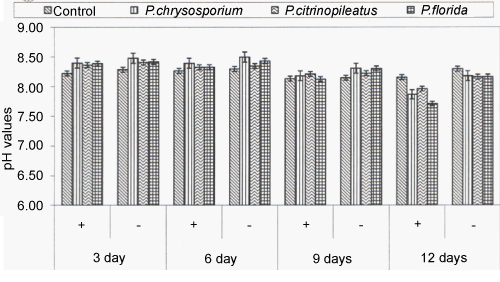 |
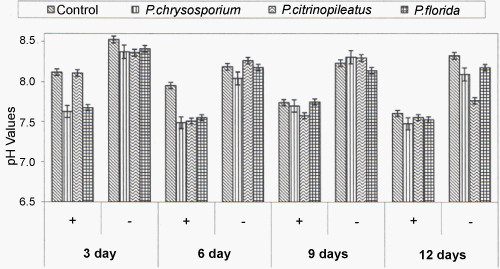 |
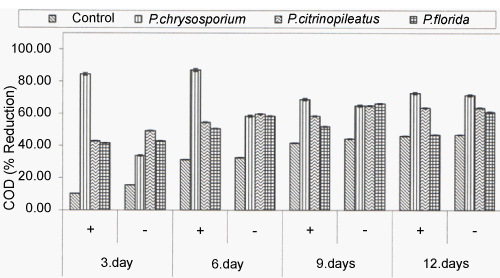 |
| Figure 1 | Figure 2 | Figure 3 |
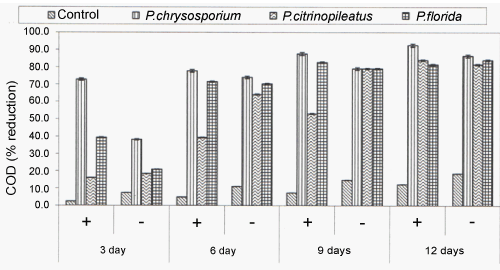 |
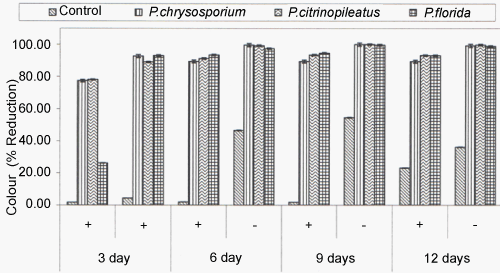 |
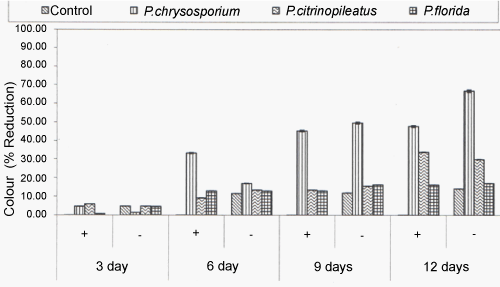 |
| Figure 4 | Figure 5 | Figure 6 |
Relevant Topics
- Anaerobic Biodegradation
- Biodegradable Balloons
- Biodegradable Confetti
- Biodegradable Diapers
- Biodegradable Plastics
- Biodegradable Sunscreen
- Biodegradation
- Bioremediation Bacteria
- Bioremediation Oil Spills
- Bioremediation Plants
- Bioremediation Products
- Ex Situ Bioremediation
- Heavy Metal Bioremediation
- In Situ Bioremediation
- Mycoremediation
- Non Biodegradable
- Phytoremediation
- Sewage Water Treatment
- Soil Bioremediation
- Types of Upwelling
- Waste Degredation
- Xenobiotics
Recommended Journals
Article Tools
Article Usage
- Total views: 15315
- [From(publication date):
May-2012 - Apr 04, 2025] - Breakdown by view type
- HTML page views : 10599
- PDF downloads : 4716
